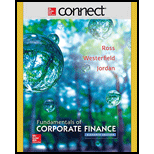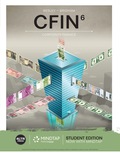
Components of Bond Returns [LO2] Bond P is a premium bond with a coupon rate of 10 percent. Bond D has a coupon rate of 4 percent and is currently selling at a discount. Both bonds make annual payments, have a YTM of 7 percent, and have 10 years to maturity. What is the current yield for bond P? For bond D? If interest rates remain unchanged, what is the expected
To determine: The interrelationship between different bond yields
Introduction:
A bond refers to the debt securities issued by the governments or corporations for raising capital. The borrower does not return the face value until maturity. However, the investor receives the coupons every year until the date of maturity. Bond price or bond value refers to the present value of the future cash inflows of the bond after discounting at the required rate of return.
Answer to Problem 32QP
The price of Bond P at present is $1,210.71, the price of Bond P after one year is $1,195.46, the current yield is 8.26 percent, and the capital gains yield is (1.26 percent).
The price of Bond D at present is $789.29, the price of Bond D after one year is $804.54, the current yield is 5.07 percent, and the capital gains yield is 1.93 percent.
The interrelationship between the different types of bond yields:
The current yield of premium bond is higher than the discount bond. The capital gains yield on premium bonds is lower than the capital gains yield on discount bonds. However, both the bonds will yield 7 percent return.
Explanation of Solution
Given information:
Bond P sells at a premium. Its coupon rate is 10 percent. Bond D sells at a discount, and its coupon rate is 4 percent. Both the bonds will mature in 10 years, have 7 percent yield to maturity, and make annual coupon payments.
The formula to calculate annual coupon payment:
The formula to calculate the current price of the bond:
Where,
“C” refers to the coupon paid per period
“F” refers to the face value paid at maturity
“r” refers to the yield to maturity
“t” refers to the periods to maturity
The formula to calculate the current yield:
The formula to calculate the capital gains yield:
Compute the annual coupon payment of Bond P:
Hence, the annual coupon payment is $100.
Compute the current price of Bond P as follows:
Hence, the current price of Bond P is $1,210.71.
Compute the price of Bond P after one year as follows:
After one year, the maturity period is 9 years. Hence, “t” is equal to 9.
Hence, the price of Bond P after one year is $1,195.46.
Compute the current yield:
Hence, the current yield is 8.26%.
Compute the capital gains yield:
Hence, the capital gains yield is (1.26 percent).
Compute the annual coupon payment of Bond D:
Hence, the annual coupon payment is $40.
Compute the current price of Bond D as follows:
Hence, the current price of Bond D is $789.29.
Compute the price of Bond D after one year as follows:
After one year, the maturity period is 9 years. Hence, “t” is equal to 9.
Hence, the price of Bond D after one year is $804.54.
Compute the current yield:
Hence, the current yield is 5.07%.
Compute the capital gains yield:
Hence, the capital gains yield is 1.93 percent.
Want to see more full solutions like this?
Chapter 7 Solutions
Connect 1 Semester Access Card for Fundamentals of Corporate Finance
- Need help in this question !properly What does “liquidity” refer to in finance? a) The profitability of a companyb) The ease of converting assets into cashc) The stability of incomed) The level of debtarrow_forwardI need help in this question! What does “liquidity” refer to in finance? a) The profitability of a companyb) The ease of converting assets into cashc) The stability of incomed) The level of debtarrow_forwardDont use chatgpt and give answer What does “liquidity” refer to in finance? a) The profitability of a companyb) The ease of converting assets into cashc) The stability of incomed) The level of debtarrow_forward
- The opportunity cost of holding cash is inversely related to the level of market interest rates. Question 9 options: True Falsearrow_forwardYour firm deals strictly with four customers. The average amount that each customer pays per month along with the collection delay associated with each payment is shown below. Given this information, what is the amount of the average daily receipts? Assume that every month has 30 days. Customer Item Amount Delay A $8,500 5 days B $12,000 2 days C $16,000 3 days D $3,600 2 days Question 8 options: $8,448 $1,337 $3,342 $1,408 $10,025arrow_forwardWhich of the following is true regarding cash management? Question 7 options: The basic objective in cash management is to keep the investment in cash as low as possible while still operating efficiently and effectively. Effective cash management results in minimization of the total interest earnings involved with holding cash. A cost of holding cash is the liquidity it gives the firm. A firm should decrease its cash holdings as long as the NPV of doing so is negative. A cost of holding cash is the interest income earned on the outstanding cash balance.arrow_forward
- Low default risk is a characteristic of money market securities. Question 6 options: True Falsearrow_forwardJeep Corp. held large sums of cash during the mid-1990s primarily because it would need a large amount of cash in the event of a recession. This is a[n] _____ for holding cash. Question 5 options: Adjustment motive. Compensating balances motive. Speculative motive. Transactions motive. Precautionary motive.arrow_forwardWith respect to the workings of a lockbox system, the cheque clearing process begins before the company even knows the payments have been received. Question 4 options: True Falsearrow_forward
- You are considering implementing a lockbox system for your firm. The system is expected to reduce the collection time by 1.5 days. On an average day, your firm receives 250 checks with an average value of $400 each. The daily interest rate on Treasury bills is .02%. What is the anticipated amount of the daily savings if this system is implemented? Question 3 options: $30 $25 $15 $20 $10arrow_forwardDisbursement float is virtually eliminated when payments are made electronically. Question 2 options: True Falsearrow_forwardAccording to your cheque book, you have a $3,000 balance in your account. You write cheques totaling $4,500 and make a deposit of $3,500. Determine your net float. Question 1 options: $8,000 -$1,000 $0 $1,000 $4,000arrow_forward
 Intermediate Financial Management (MindTap Course...FinanceISBN:9781337395083Author:Eugene F. Brigham, Phillip R. DavesPublisher:Cengage Learning
Intermediate Financial Management (MindTap Course...FinanceISBN:9781337395083Author:Eugene F. Brigham, Phillip R. DavesPublisher:Cengage Learning




